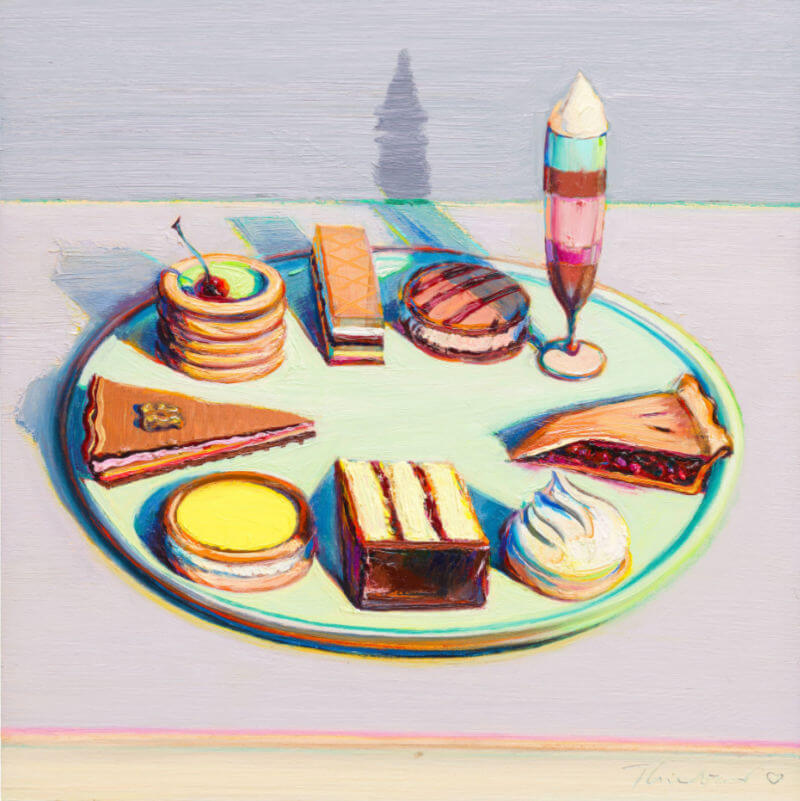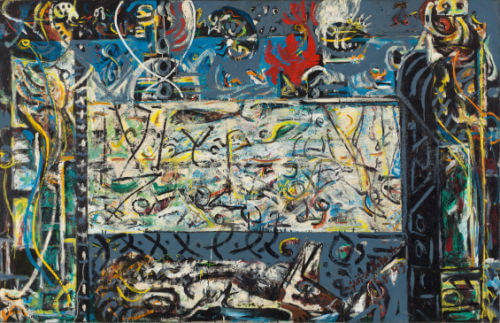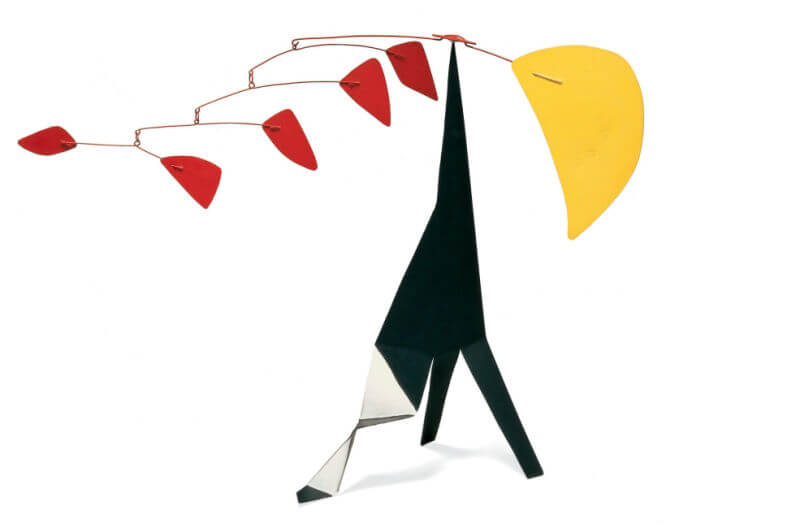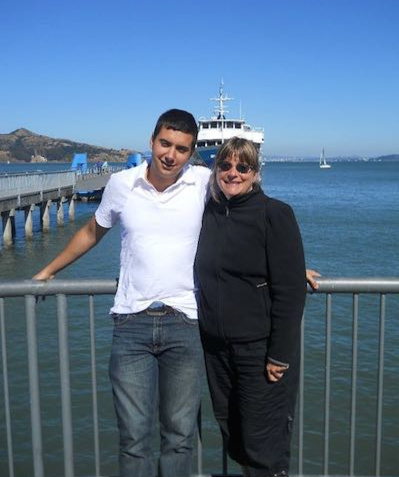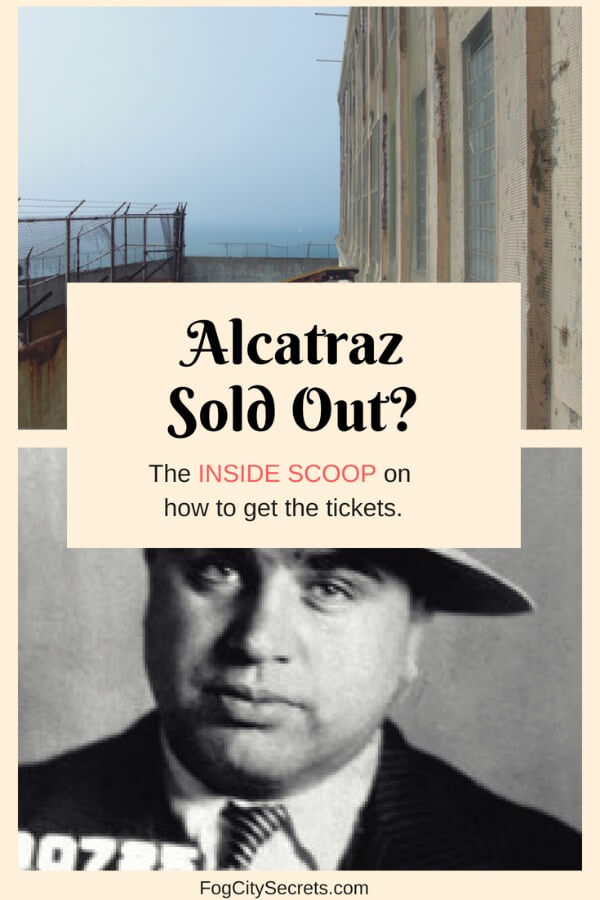- Home
- San Francisco Museums
- SF MOMA
The San Francisco Museum of Modern Art
Highlights of SF MOMA from a local

San Francisco has a beautiful, modern art museum, which was extensively remodeled in 2016. The museum has a huge collection and hosts new exhibitions frequently.
Is SFMOMA worth a visit? Absolutely! Whether you like "modern" art or not.
It presents a very inviting venue to view contemporary art, plus it's got some great views of downtown San Francisco! The building itself is pretty amazing, too.
Visiting SFMOMA
Hours
Mon-Tue: 10-5
Wed: closed
Thur: 12-8
Fri-Sun: 10-5
Tickets
Adults: $30
Seniors (65+): $25
Students (full time, ID): $23
18 and under: free
Visiting tips
Maps, public transport, parking
Exploring the art
Exploring the building
Eating & shopping
History of SFMOMA
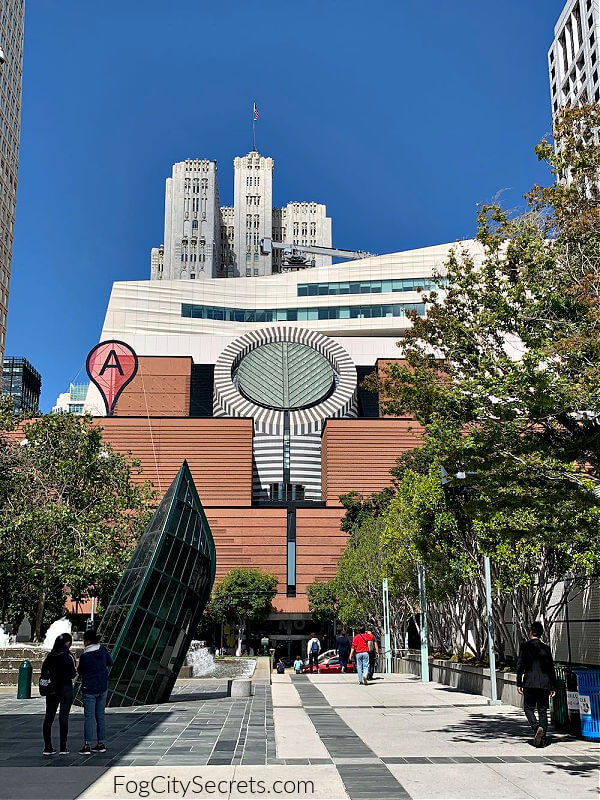 Entrance to SFMOMA
Entrance to SFMOMAI may earn a small commission if you make a purchase through some of the affiliate links on this page. See disclosure policy. This helps me provide all the free information on the site. Thank you!
What if you can't stand modern art?
Or just abstract expressionism :(
Go anyway! It's fun to visit either way!
SFMOMA provides a good two to three hours of entertainment. If you enjoy modern art, there's seven floors with lots to explore and appreciate. It's a huge space with vast exhibition areas and lots of variety: prints, paintings, sculptures, photography, and multimedia.
If you hate modern art, it's a vast playground with boundless opportunities for snide comments and humorous critiques.
Either way, the museum also has some spectacular city views from some of the balconies and walkways; worth a visit just for that! And the building itself is pretty dazzling.
 Alice isn't fond of modern art
Alice isn't fond of modern art"Modern art" in the museum covers all of the genres from the early 1900s, including post-impressionism, cubism, fauvism, and expressionism, through the 20th century art approaches of abstraction, modernism, surrealism and others, and on to this century's abstract expressionism, minimalism, post-modernism, and more.
All the usual suspects are here, like Pablo Picasso, Vincent van Gogh, Henri Matisse, Wassily Kandinsky, Mark Rothko, Robert Rauschenburg, Paul Cezanne, Paul Gaugin, Andy Warhol, Jackson Pollock, Diego Rivera, Frida Kahlo, plus many artists most people haven't heard of.
The collection and exhibits include paintings, prints, drawings, sculpture, photography, video, and immersive experiences.
What's not to like?
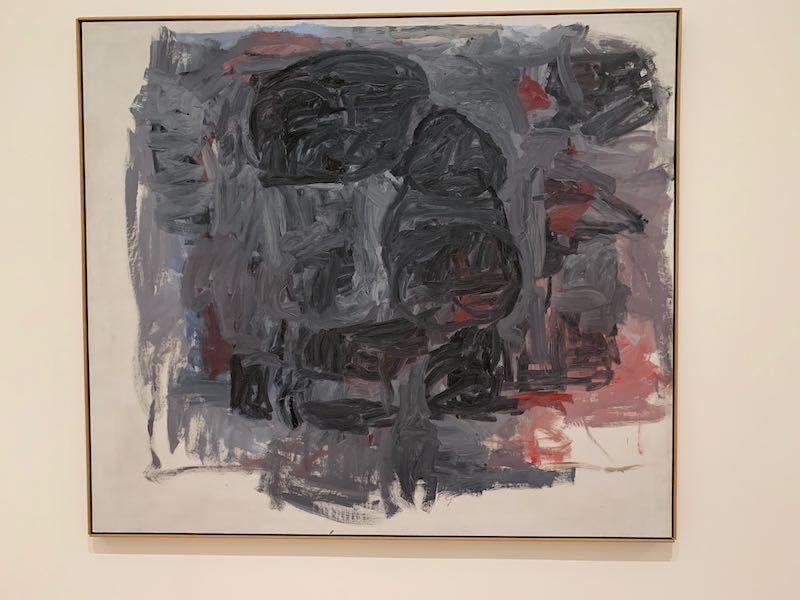 Late Fall, by Philip Guston, 1963
Late Fall, by Philip Guston, 1963But they also have paintings by Matisse...
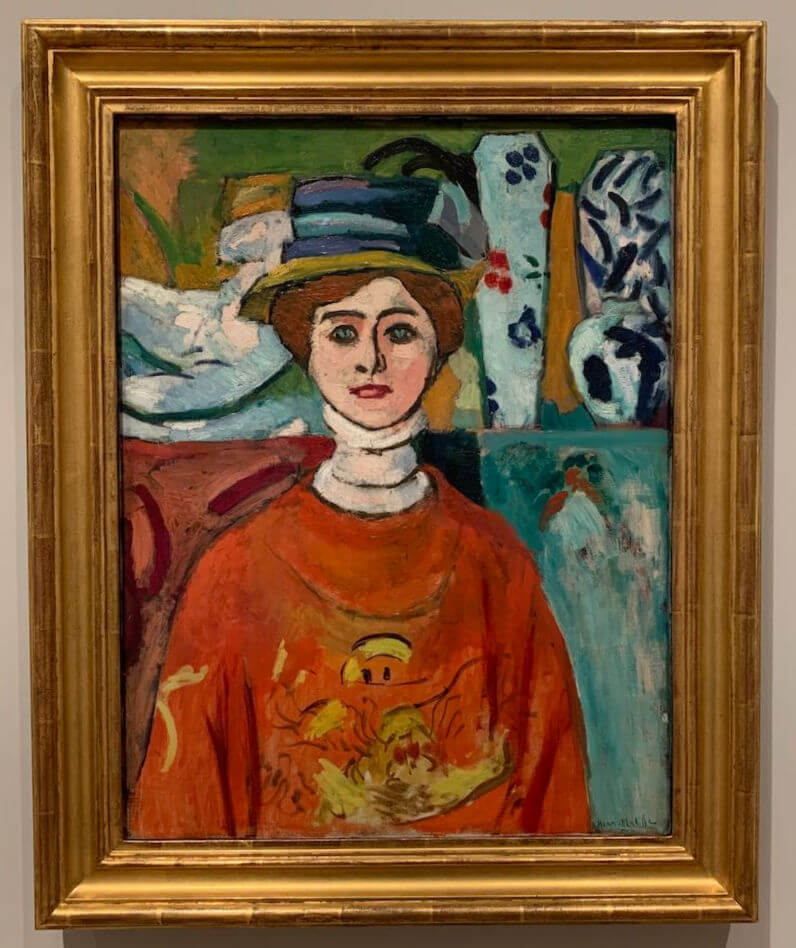 The Girl with Green Eyes, Henri Matisse (1908)
The Girl with Green Eyes, Henri Matisse (1908)and works by Andy Warhol.
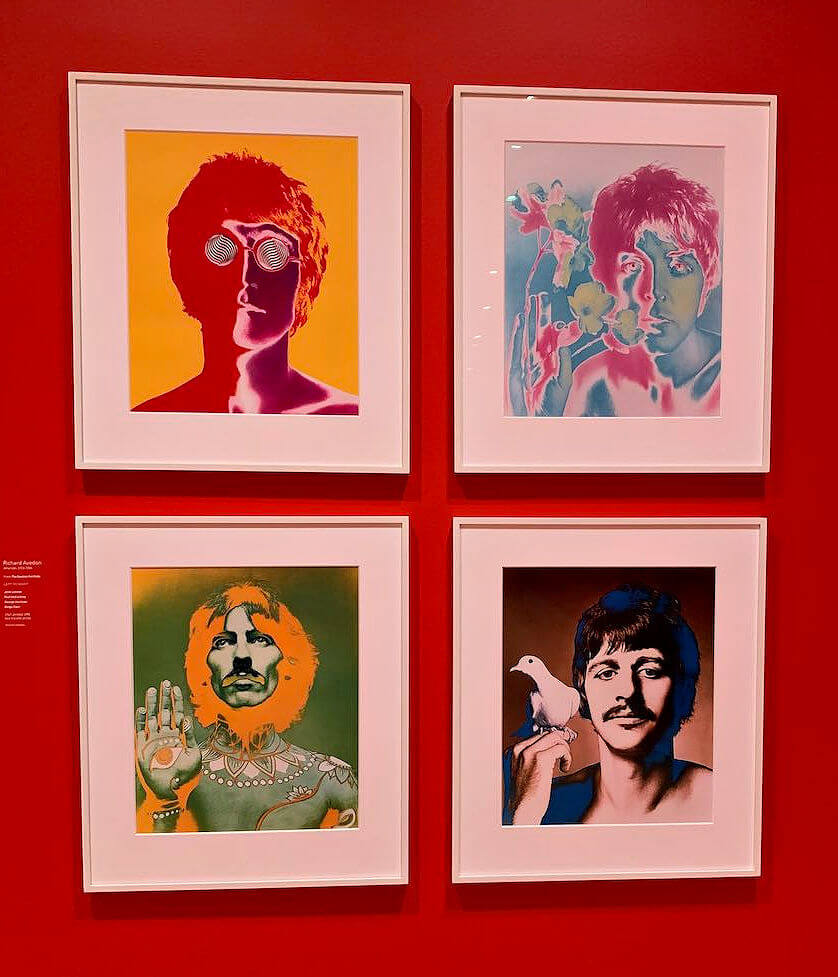 The Beatles posters, Andy Warhol (1967)
The Beatles posters, Andy Warhol (1967)The Beatles posters above were part of a visiting exhibit when I went, but they also have a sizable Warhol collection of their own in the museum.
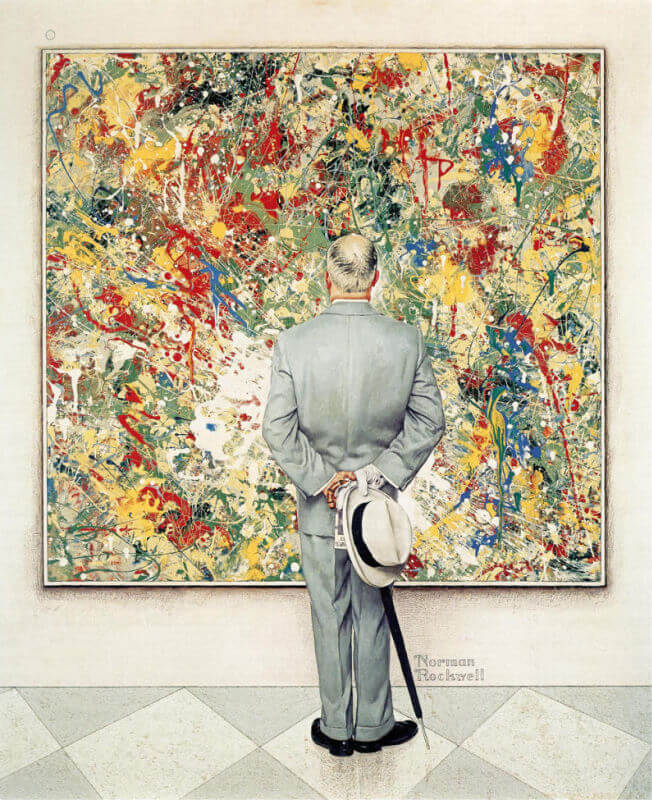 The Connoisseur, by Norman Rockwell, 1962
The Connoisseur, by Norman Rockwell, 1962Norman Rockwell created a painting in the style of Jackson Pollock in his studio, then included it in the painting above, The Connoisseur. It was used as the cover for a 1962 Saturday Evening Post edition.
What did he think of modern art? The painting suggests traditional, representational art contemplating abstract expressionism.
Tips for your visit - save money, avoid the crowds, find what you want to see, and more.
Go on a weekday, if you can. And avoid the free days for locals (first Thursday of the month) to avoid crowds. But it's not usually crowded unless there is a popular special exhibit happening.
Check out the current exhibits to plan what you want to see.
Take a look at the floor map to see where the exhibits are (plus the restaurants and store).
You can hear audio comments on certain works by going to the artwork's page on their website and checking below it to see if there's an audio or video associated with it.
If you're visiting the museum, you can go to their website at audio descriptions and put in the number located on the plaque next to the work to hear commentary on the work. Or login to the museums' free wifi.
Save money. The museum is a bit pricy, but there are ways of reducing the cost. Some of the attraction passes include SFMOMA. And various free options, like occasional free days for all and free tickets for certain groups.
- San Francisco City Pass (up to 46% off)
- San Francisco Go City Explorer Pass (up to 50% off)
First Thursday of the Month. Free for Bay Area residents (Alameda, Contra Costa, Marin, Napa, San Francisco, San Mateo, Santa Clara, Solano, and Sonoma counties).
Free areas of the museum. The museum provides 45,000 square feet of space open to the public for free, with changing art exhibits, on Floors 1 and 2.
Eating at the museum.
- grace. Outdoor restaurant on Floor 1, French/American
- Steps Coffee. Indoor cafe. Coffee and sweets, Floor 2
- Cafe 5. Indoor/outdoor cafe in the sculpture garden, Floor 5
 Cafe 5, Roof Garden on Floor 5
Cafe 5, Roof Garden on Floor 5Museum Store. All sorts of cool stuff. Framed art, books, jewelry, weird socks, etc. Located on Floor 1.
The following images of art works are from the SF MOMA collection, www.sfmoma.org
What is there to see at SFMOMA?
What's on right now? Check out the current exhibits.
How to hear audio about the art work. When you're at the museum, some of the art works have an audio discussion of the piece you can hear while you're looking at it. Check the written information to the side of the work and look for a phone symbol and number. Access the museum's free wifi and go to sfmoma.org/audio.
For example...
 Ives Klein, IKB 74, 1958
Ives Klein, IKB 74, 1958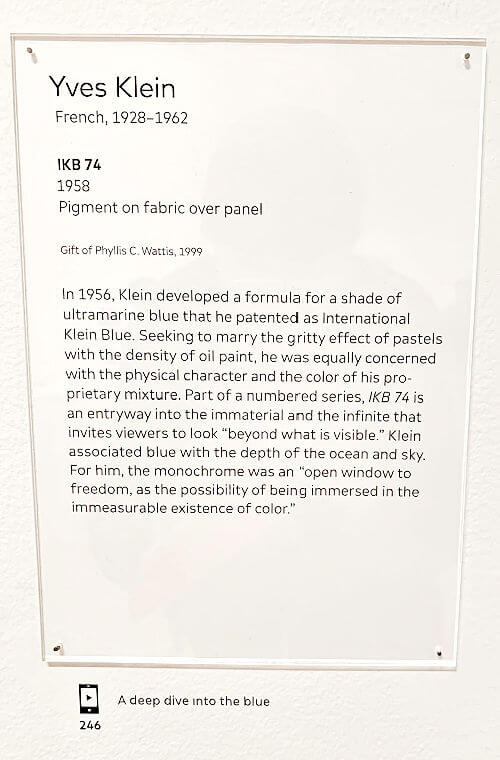 Audio for painting available, with number key below.
Audio for painting available, with number key below.
"Entryway into the immaterial and the infinite". "The possibility of being immersed in the immeasurable existence of color" (according to the artist).
 Untitled 1, by Barnett Newman, 1970
Untitled 1, by Barnett Newman, 1970(Not to be confused with Barnett Newman's work, Untitled 1, from 1970.)
See some possibly unkind words about Newman's paintings from Tom Wolfe further down.
This museum houses San Francisco's vast, official collection of "modern" art.
SF MOMA has a permanent collection, which they rotate in and out of view, and visiting art, showcased in special exhibitions during the year.
Looking for a specific artist or work at SFMOMA?
You can explore their permanent collection online and sort by date, type of work, and artist, and also filter by whether the work is currently on exhibit. Pretty cool.
Many of the works have an audio description of the piece on the website; check for audio or video under "more". Also, when viewing an exhibit, you can use your phone to hear about the art work when visiting the museum (by posted number).
See the SF MOMA collection.
Check out these better-known artists in the MOMA permanent collection:
One of the most fascinating aspects of visiting this museum is the variety of styles and unexpected surprises one encounters during a visit.
Here's a small sample of what you might encounter during a visit:

Lesende (Reader), by Gerhard Richter, 1994
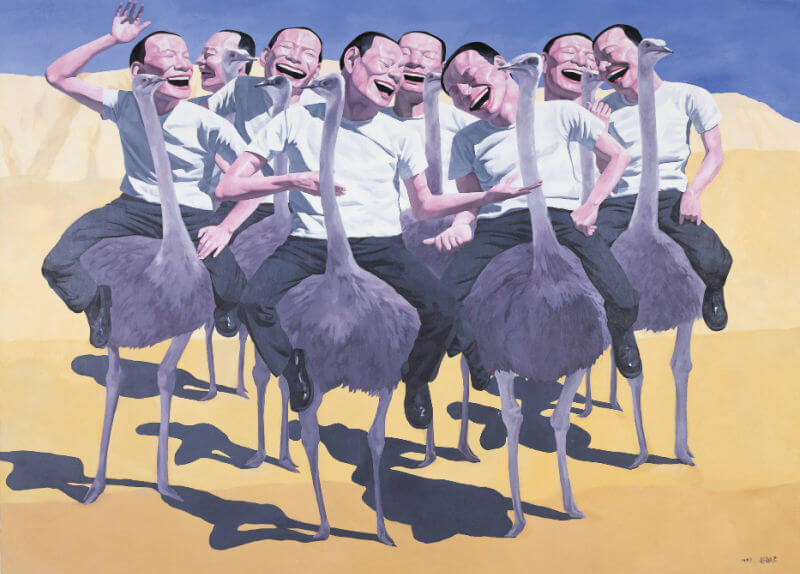
Ostiches, by Minjun Yue, 1997
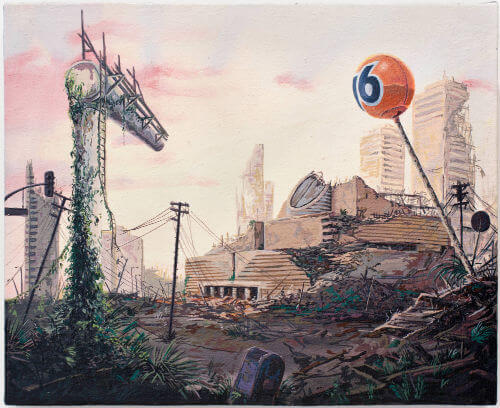
Scene from the Desolation, by Sandow Birk, 1995
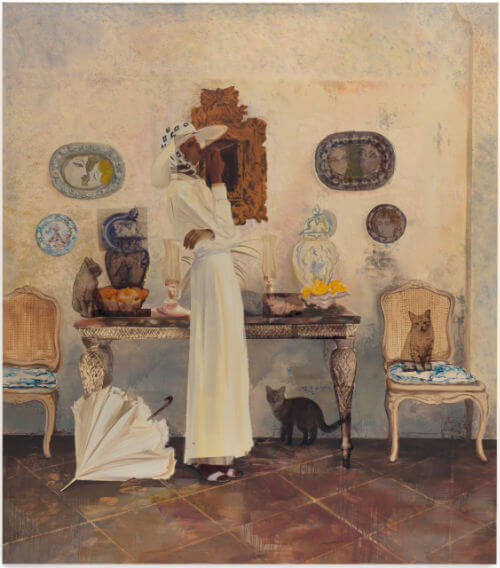
A Portrait of the Artist Indoors, by Paulina Olowska, 2012

Popeye, by Kristen Morgin, 2006

under pressure from the inside, by Woody De Othello, 2018
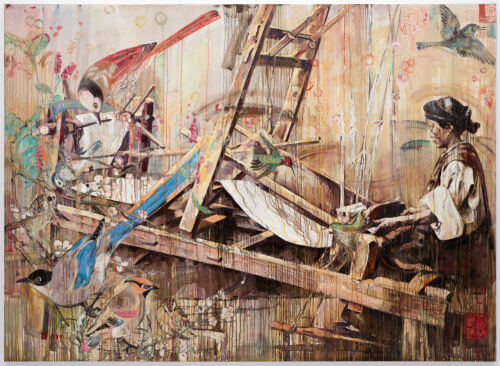
Loom, by Hung Liu, 1999

Potrero Hill, by Robert Bechtle, 1996
There are also plenty of works like these...(you've been warned).

Purloined, by Samuel Levi Jones, 2015
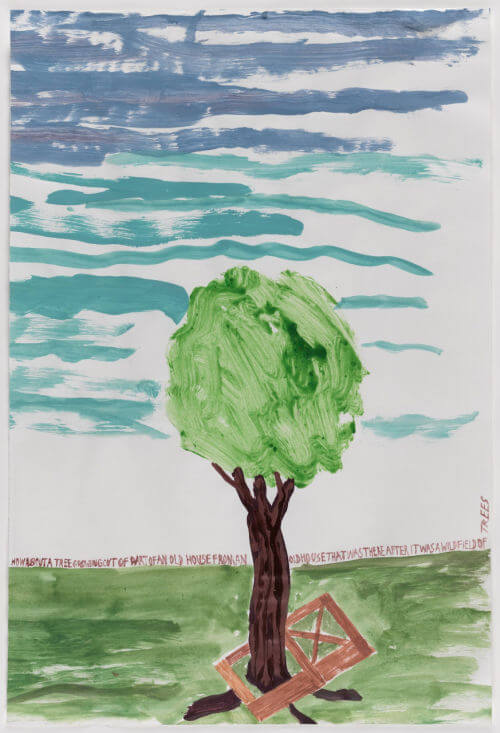
How About a Tree...., by Chris Johanson, 2013
Joan Mitchell's paintings, Philip Guston's paintings
Two of the prominent abstract expressionist painters included in the Fisher Collection are Joan Mitchell and Philip Guston. Not everyone's cup of tea.
One of the paintings in the Fisher Collection is Joan Mitchell's painting, Bracket. It was on display one time when I was visiting the museum.
When I walked into the room, I have to admit that for a fraction of a second, I thought someone had vandalized the painting! No, it's supposed to look like that. I'm not a fan, as you would guess.
 Bracket, by Joan Mitchell, 1989
Bracket, by Joan Mitchell, 1989From SFMOMA curator Sarah Robert's comments on this painting in connection with an exhibition of Mitchell's works: "With surging strokes of cobalt blue, sienna, and emerald punctuated by surprising flashes of pink and chartreuse, the painting manifests a sense of impassioned discovery through color."
She painted 100s of large canvases like this over the decades (1950s-1980s) in the style of abstract expressionism and her paintings were financially very successful, both during her lifetime and after (she died in 1992).
One of her paintings, Untitled (1960), sold for $11.9 million in 2014, which was a record for any work by a woman artist sold at auction.
 Untitled (1960), by Joan Mitchell
Untitled (1960), by Joan MitchellThat's not the worst, either.
My most unfavorite artist at SFMOMA is not Joan Mitchell. It's Philip Guston. That's one of his paintings at the top of the article, Late Fall. Another example is one I saw on a visit to SFMOMA, Processional, 1957, below.
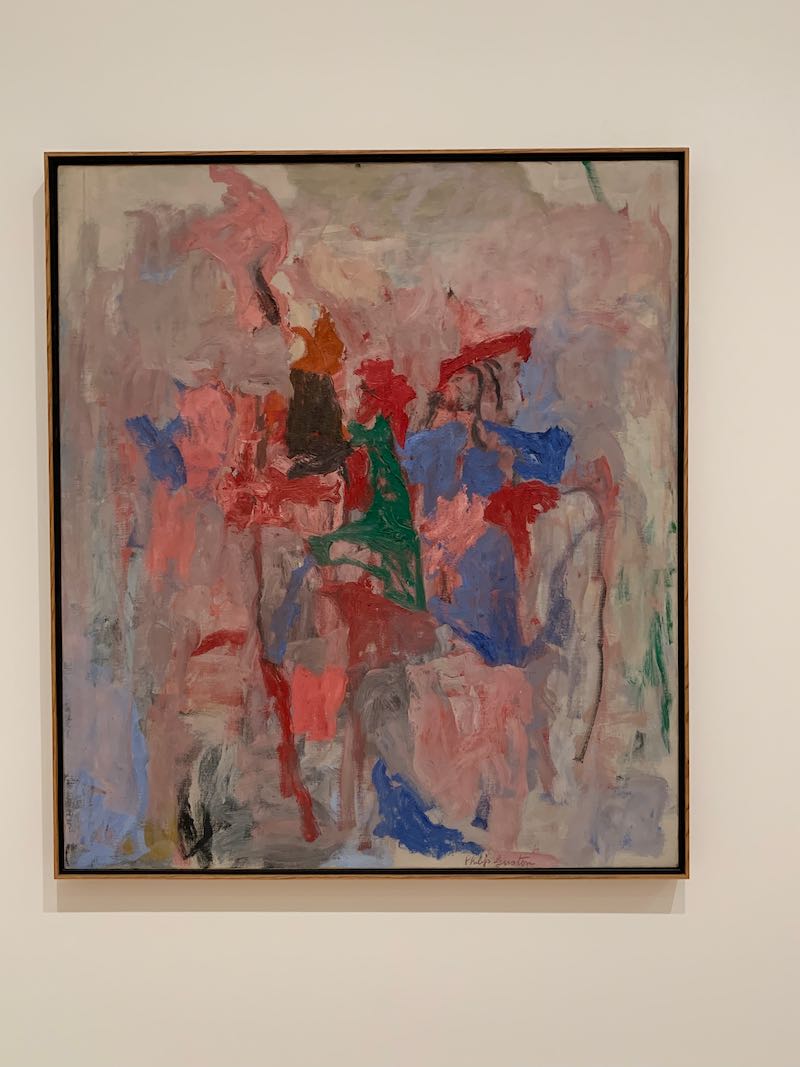 Processional, by Philip Guston, 1957
Processional, by Philip Guston, 1957The painting's description included a quote from Guston, talking about a similar painting:
"The black seemed to be swallowing the red, and another form of the red swallowed the black. Almost as if the very colors, the very paint, the very matter, were doing things to each other."
Tom Wolfe's hilarious assault on "modern art"
In 1975, impish author Tom Wolfe wrote a famous send-up of the art establishment and eviscerated their admiration of abstract expressionism and "flatness" in painting, in his short book,The Painted Word.
Essentially, he critiqued the vast, complex, intellectual analyses by art "experts" of what appeared to most people to be simple and crude paintings. The theme of the book is that these paintings required reams of sophisticated commentary to be understood, and whose appreciation depended on highly intellectual deep-dives into art theory. Nothing the bourgeoisie could understand! Needless to say, his book was not well-received by the art critics.
And he did it with biting wit. For a hilarious trip through the upper reaches of art theory, take a look at The Painted Word on Amazon. Modern Art will never look the same.
For example, he mentioned the artist Barnett Newman, an American abstract expressionist, known for his extensive writings about art and for his paintings of large fields of color with a stripe of a different color. Here's a sample...
 Who's Afraid of Red, Yellow and Blue II, by Barnett Newman, 1967
Who's Afraid of Red, Yellow and Blue II, by Barnett Newman, 1967 Onement 1, by Barnet Newman, 1948
Onement 1, by Barnet Newman, 1948 Canto II from 18 Cantos, by Barnett Newman, 1964
Canto II from 18 Cantos, by Barnett Newman, 1964 Canto VI from 18 Cantos, by Barnett Newman, 1963
Canto VI from 18 Cantos, by Barnett Newman, 1963Barnett Newman perspective from writer Carter Ratcliff:
"Newman’s forms keep calling their internal relationships into question, moment by moment, and thus my immersion in a field of color immerses me in the flow of real time. At its most intense, this awareness of time and contingency ushers in a state of exaltation focused, ultimately, on me. Thus I find my way to the subject of Newman’s art, which he described as “the self, terrible and constant.” Fleeing the terribilitá of one’s isolated self, one returns to the reassuring but less consequential realm of shared experience."
Carter Ratcliff,"The Self, Terrible and Constant" A Note on the Art of Barnett Newman.
Tom Wolfe on Barnett Newman:
"Yet Newman himself happened to be one of the most incessant theoreticians on Eighth Street, and his work showed it. He spent the last twenty-two years of his life studying the problems (if any) of dealing with big areas of color divided by stripe...on a flat picture plane.”
Referring to the art collectors, Wolfe said “how they tried to internalize their theories to the point where they could feel a tingle or two at the very moment they looked at an abstract painting…without first having to give the script a little run-through in their minds. And some succeeded.”
Don't feel too bad if you don't feel the "tingle".
For a taste of art professors and art students discussing the work below, the meaning of the "zips" (or vertical lines in the painting) in particular...
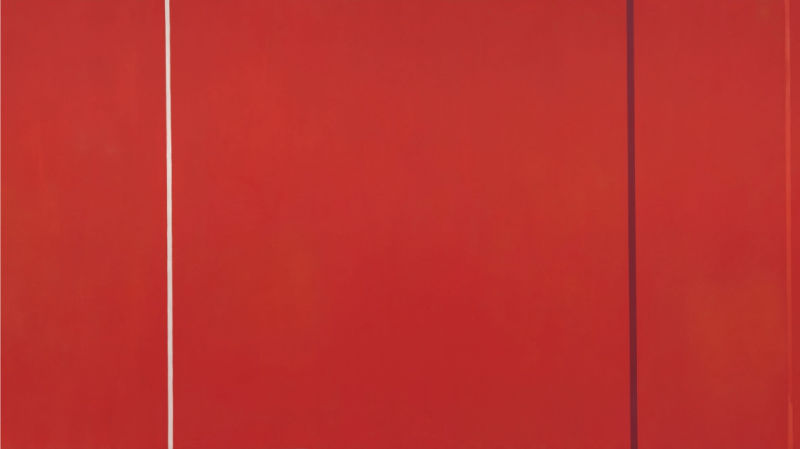 Vir Heroicus Sublimis, Barnett Newman, 1950-51
Vir Heroicus Sublimis, Barnett Newman, 1950-51"And some art historians and critics, and some art historians and critics, because they move from the complete top of the canvas to the bottom of the canvas and occupy space, sort of completely create a very complex formal statement about this notion of an expression of the canvas itself as an expression of painting. It becomes a sort of full expression of the height of the canvas, of its length, of its sort of formal existence."
"There's something really interesting going on which is that you have sort of different densities of zips, almost creating kind of a community of isolation."
(Above text is from the transcripts of the YouTube video below.)
One of the art students admits she isn't feeling much from looking at the painting, that she worries that she should be feeling more. Points for honesty.
Exploring the building
Aside from enjoying the art, the building itself is something to see.
The entryway is a large area with exhibits to see even before you buy a ticket. This area is open to the public free of charge and changes the art work periodically.
There are seven floors of artwork, after you get past the entry foyer.
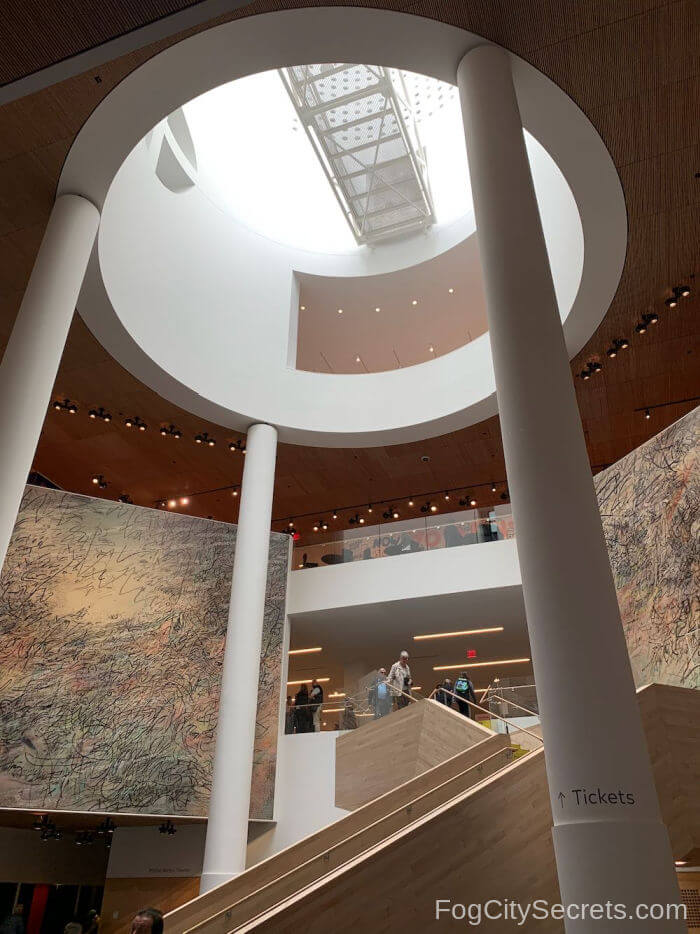 Entryway and atrium
Entryway and atriumThe atrium is a massive skylight that rises through the floors of exhibits.
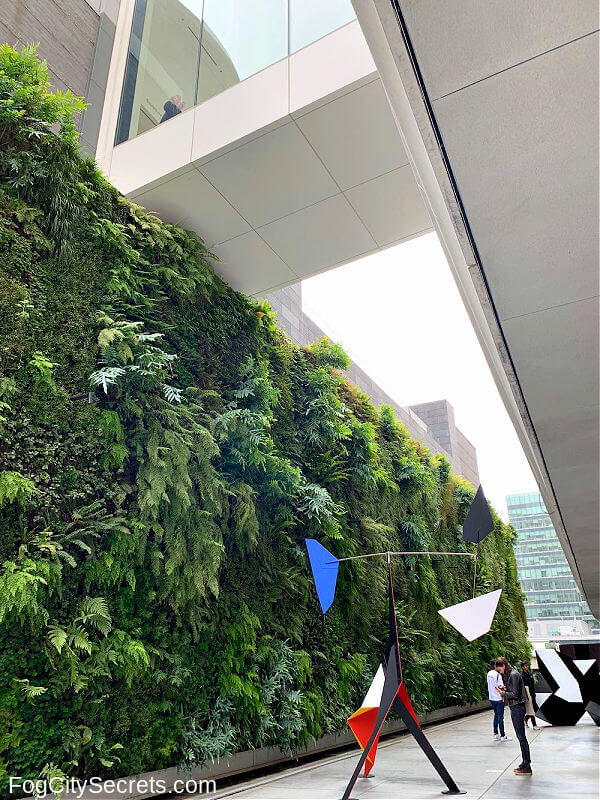 Living wall, with bridge to roof garden above
Living wall, with bridge to roof garden aboveThe living wall was added during the 2016 remodel; it's on the third floor, off a sculpture gallery. The bridge above is on the fifth floor and goes to the roof garden.
There are also some spectacular views of downtown San Francisco from the roof garden on the fifth floor, and from a long balcony off the seventh floor (best views).
 SFMOMA balcony view, seventh floor
SFMOMA balcony view, seventh floor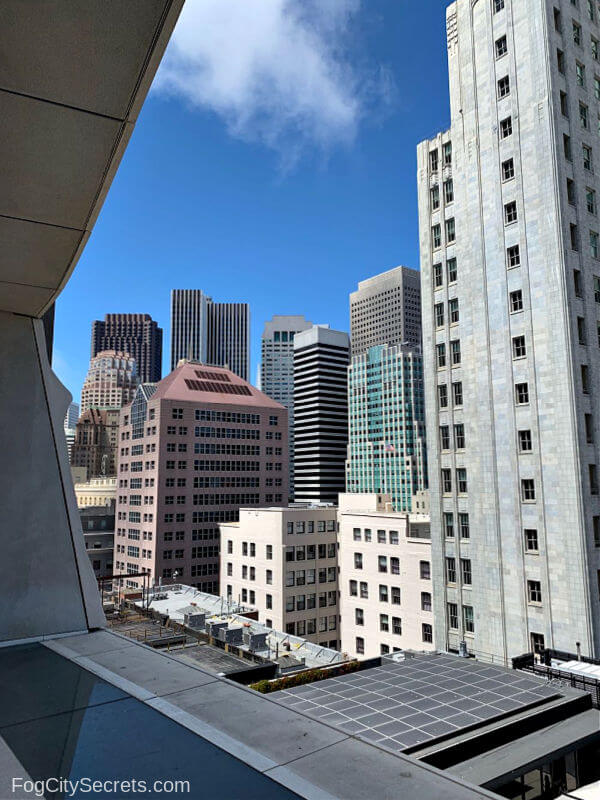 City view from seventh floor balcony
City view from seventh floor balcony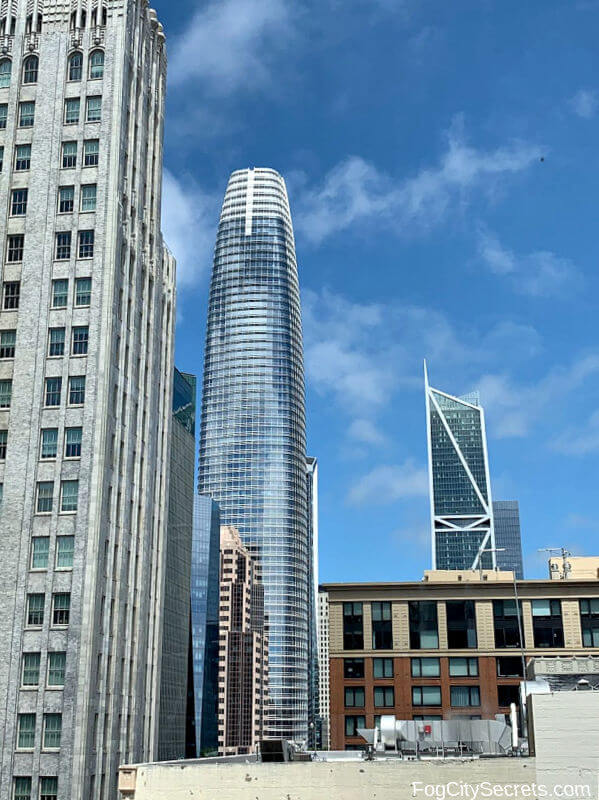 View of Salesforce Tower and Millennium Tower, from fifth floor walkway to roof garden
View of Salesforce Tower and Millennium Tower, from fifth floor walkway to roof garden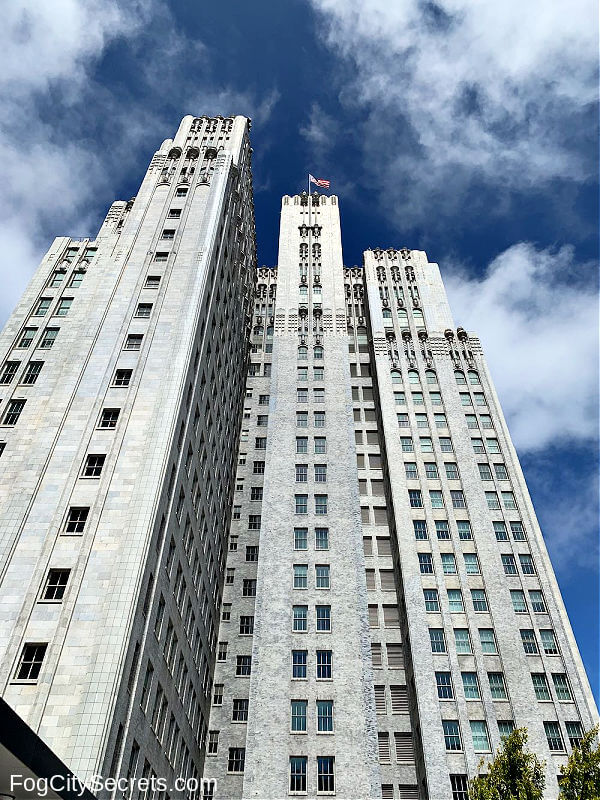 Art deco San Francisco skyscraper behind SFMOMA
Art deco San Francisco skyscraper behind SFMOMAHistory of SFMOMA
The current building was designed by Swiss architect Mario Botta and opened to the public in 1995. A rooftop garden and restaurant (on top of the adjacent parking garage) were added in 2009.
The museum then underwent a major expansion and reopened in 2016 after a three-year closure during construction. The addition added more floors and a rear section, and doubled the exhibition area of the building.
The aery atrium that greets visitors was part of the original building and the floors of galleries still rise around it.
The expansion was a response to the increasing size of the art collection. A major contributor to the MOMA's art was a loan (for 100 years!) of the Doris and Donald Fisher Collection (founders of the Gap), including many of the "big names" of contemporary art, like Andy Warhol, Roy Lichtenstein, Joan Mitchell, Alexander Calder, Wayne Thiebaud, Philip Guston, and more.
Getting to SFMOMA
The museum's address is 151 Third Street and it's located in the South of Market area, one block south of Market Street, and across the street from Yerba Buena Center (some fun activities in there).
Public transportation. It's very convenient for the underground BART trains and the Muni streetcars (also underground below Market Street). The Montgomery Street stop (for both systems) is about a two block walk to the museum. It's also about three blocks from the Transbay Terminal if you're busing it from the East Bay.
Map of SFMOMA and downtown SF
By car. It's also pretty easy to drive here.
Parking. Street parking is challenging, but the SFMOMA Garage is a short walk from the museum. The entrance is at 147 Minna Street, around the corner from the museum entrance.
Hours: 7 am - 11 pm daily
Fees: $4 per each 30 minutes, up to 3.5 hours. Past 3.5 hours, a flat $26 (up to 10 hours). You can get a 10% discount during the first 3.5 hours, validation at the desk.
It's not physically connected, but just a short walk to the museum entrance. This is where I park. The spaces can be on the tight side, so go higher to get more room.
 Entrance to the parking garage on Minna Street
Entrance to the parking garage on Minna StreetLocal tip: leave nothing in your car. Thieves haunt parking garages in this area, like other tourist areas in the city.
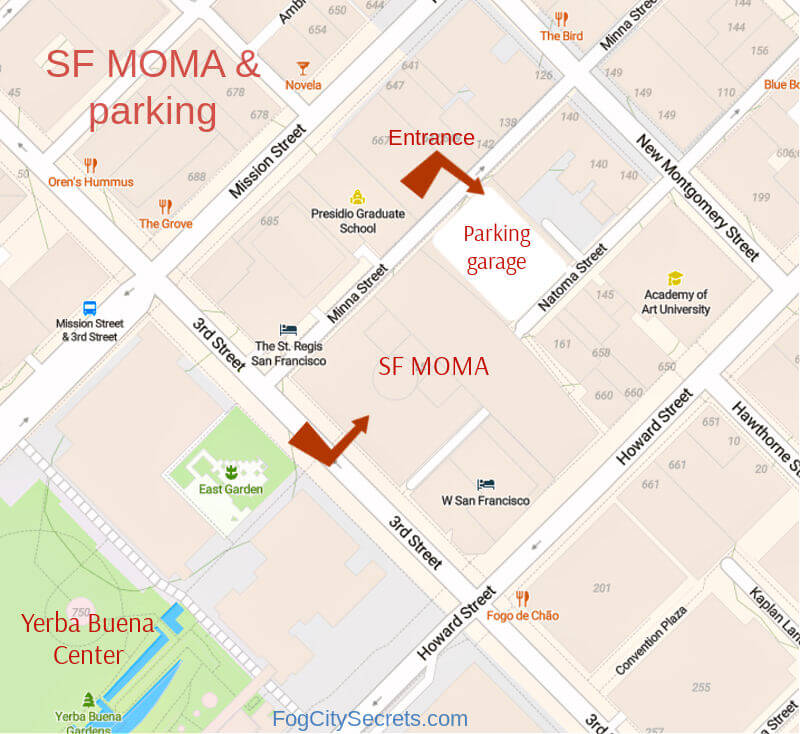
Alternatives to SF MOMA garage:
- Valet parking at the St Regis Hotel next door, 180 Minna St.
- Valet garage parking at 164 Tehama St. (5 min walk)
- Museum Parc Garage, 300 3rd St. (4 min walk)
Check prices and availability at Spot Hero. You can also reserve spots through them.
Hotels nearby...
There are some nice hotels within a block or two of the museum if you want to stay in that area. A rating of 8 and above is very good.
This is generally an okay area to stay in. The stretch of Market Street further down (5th through 10th) is not good. See my article on good and bad areas of San Francisco.
St. Regis Hotel (next door to museum, rated 9.3 "wonderful", swimming pool, parking)
W San Francisco (next to museum, 8.5 rated, parking).
Hyatt Regency (8.8 rated, parking)
Palace Hotel (very pretty, 8.5 rated. Swimming pool, parking)
Four Seasons (8.8 rated, parking)
SF Marriott Marquis (8.3 rated, parking)
Here's my article on the best areas to stay in San Francisco: safest areas, best for first-timers, best for families, and more.
More great San Francisco art museums:
- de Young Museum. Wide variety of art and sculpture from around the world.
- Legion of Honor Museum. Large collection of traditional European art.
- Asian Art Museum. Art from all over Asia, mostly historical works.
Share this page:
